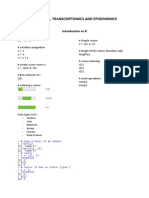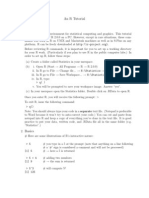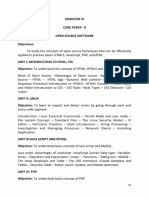Basic R Commands
Uploaded by
CristianAlejandroGirónAlvaradoBasic R Commands
Uploaded by
CristianAlejandroGirónAlvaradoBasic R Commands
Fabian Fopp
11/25/2020
Basic R commands
To assign an object we use the assignemnt arrow “<–”.
x <- 5
In this case x is a number, but we can also assign more complex stuctures such as vectors, matrices, dataframes or lists. Results of operations
assigned to objects are usually not printed in R. If we put the entire command in brackets we can see the result in the console.
(x <- seq(1, 10))
## [1] 1 2 3 4 5 6 7 8 9 10
str(x)
## int [1:10] 1 2 3 4 5 6 7 8 9 10
x is a one dimensional array (=vector). The data type of this vector is “int” which stands for integer. There are also other data types such as
numeric, character and factor.
x <- c("GR_1", "GR_2", "ti_1", "VS_1", "VS_2")
str(x)
## chr [1:5] "GR_1" "GR_2" "ti_1" "VS_1" "VS_2"
This time the data type of x is classified as character (“chr”). Imagine however x stores different treatment levels in an experiment, such as a low
nitrogen, medium nitrogen and high nitrogen treatment. In this case we want to treat x as a factor with different levels (in this case three).
y <- as.factor(c("low", "low", "high", "medium", "low"))
str(y)
## Factor w/ 3 levels "high","low","medium": 2 2 1 3 2
To access an element of a vector we should first know how long this vector is. We can do this using the length() function:
length(x)
## [1] 5
We can then use square brackets for the indexing. The index of an element is basically the address (position) inside of the vector in which it is
stored.
x[3]
## [1] "ti_1"
(x[3] <- "TI_1")
## [1] "TI_1"
As mentioned before, we store all observation data from the field in a dataframe. A dataframe has two dimensions with n rows and m columns. A
dataframe can (in contrast to a matrix) also store different data types in different columns.
z <- as.data.frame(cbind(c("GR_1", "GR_2", "TI_1", "VS_1", "VS_2"),
c("low", "low", "high", "medium", "low"), c(4, 4, 8, 6, 5)))
Now we will have a look at how to access a certain element of a dataframe (or matrix). Let’s take our dataframe z as an example, which has three
columns and five rows. If we don’t know the dimensions of our dataframe we can use the dim() funtion to find out:
dim(z)
## [1] 5 3
The indexing of dataframes works similar to the indexing of vectors except that we are now dealing with two dimensions. The first value in the
square brackets is the index of the row, the second one is the index of the column.
z[1, 2]
## [1] "low"
z[, 2]
## [1] "low" "low" "high" "medium" "low"
Especially if we are dealing with large dataframes this can get tedious and we can easily make mistakes when accidentally selecting the wrong
column index. It makes things much easier if we name the different columns of our dataframe.
colnames(z) <- c("plot_id", "treatment", "ph")
We can now access the columns by names using the $ sign.
z$treatment[1]
## [1] "low"
If we want to print the whole treatment column we can just omit the square brackets with the index:
z$treatment
## [1] "low" "low" "high" "medium" "low"
Finally, if we want to select multiple rows but not all of them, we can do that using the colon.
z$treatment[3:nrow(z)]
## [1] "high" "medium" "low"
If we check the structure of our dataframe z we can see that R treats all columns as factors. We want to change the plot_id column to character
and the ph column to numeric (so that we can also perform calculations later). When converting factor to numeric it is important to convert it to
character first:
str(z)
## 'data.frame': 5 obs. of 3 variables:
## $ plot_id : chr "GR_1" "GR_2" "TI_1" "VS_1" ...
## $ treatment: chr "low" "low" "high" "medium" ...
## $ ph : chr "4" "4" "8" "6" ...
z$plot_id <- as.character(z$plot_id)
z$ph <- as.numeric(as.character(z$ph))
str(z)
## 'data.frame': 5 obs. of 3 variables:
## $ plot_id : chr "GR_1" "GR_2" "TI_1" "VS_1" ...
## $ treatment: chr "low" "low" "high" "medium" ...
## $ ph : num 4 4 8 6 5
You might also like
- Introduction To Programmable Logic Controllers (PLCS)No ratings yetIntroduction To Programmable Logic Controllers (PLCS)20 pages
- Lecture_5_(Managing_and_Understanding_Data)No ratings yetLecture_5_(Managing_and_Understanding_Data)9 pages
- R Programming: © 2016 SMART Training Resources Pvt. LTDNo ratings yetR Programming: © 2016 SMART Training Resources Pvt. LTD28 pages
- X - 15 x-1 2. Print ('Hello Word!') ## (1) "Hello Word!" 3. X - 4 y - 5 Z - X+y Print (Z) 4. X - 4 y - 5 Cat ('The Sum of X and y Is', X+y)No ratings yetX - 15 x-1 2. Print ('Hello Word!') ## (1) "Hello Word!" 3. X - 4 y - 5 Z - X+y Print (Z) 4. X - 4 y - 5 Cat ('The Sum of X and y Is', X+y)15 pages
- R/Rpad Reference Card: Slicing and Extracting DataNo ratings yetR/Rpad Reference Card: Slicing and Extracting Data5 pages
- Lab 1- Basic functions in R and plottingNo ratings yetLab 1- Basic functions in R and plotting8 pages
- Introduction To R: Nihan Acar-Denizli, Pau FonsecaNo ratings yetIntroduction To R: Nihan Acar-Denizli, Pau Fonseca50 pages
- Practical 1_Data Frame Manipulation_072502No ratings yetPractical 1_Data Frame Manipulation_07250216 pages
- R For Machine Learning Lab Practical Work: Master of Business Administration in Business Analytics0% (1)R For Machine Learning Lab Practical Work: Master of Business Administration in Business Analytics9 pages
- 2016 04 27 Cmpe 140 Computing Econ 09 Graphics ContinuedNo ratings yet2016 04 27 Cmpe 140 Computing Econ 09 Graphics Continued28 pages
- Graphs with MATLAB (Taken from "MATLAB for Beginners: A Gentle Approach")From EverandGraphs with MATLAB (Taken from "MATLAB for Beginners: A Gentle Approach")4/5 (2)
- 2-IJCI Vol. 3 No. 3-March 2024-Paper1-Dr. ElrasheedNo ratings yet2-IJCI Vol. 3 No. 3-March 2024-Paper1-Dr. Elrasheed33 pages
- Versana Premier Vet R3 Basic Service Manual - SM - 5946511-1EN - 4No ratings yetVersana Premier Vet R3 Basic Service Manual - SM - 5946511-1EN - 4385 pages
- Module 38: Understanding Siebel Event ModelsNo ratings yetModule 38: Understanding Siebel Event Models15 pages
- Substantial Capabilities of Robotics in Enhancing Industry 4.0No ratings yetSubstantial Capabilities of Robotics in Enhancing Industry 4.018 pages
- B CH Config Xe 16 11 1 ncs4200 - Chapter - 01011No ratings yetB CH Config Xe 16 11 1 ncs4200 - Chapter - 0101134 pages
- AP0410 Globaloperationsbulletinno31march2017 20180319 102522No ratings yetAP0410 Globaloperationsbulletinno31march2017 20180319 102522139 pages
- Stack, Queue, Recursion and Bit Manipulation PDFNo ratings yetStack, Queue, Recursion and Bit Manipulation PDF9 pages
- Software Requirements Specification: Version 1.0 ApprovedNo ratings yetSoftware Requirements Specification: Version 1.0 Approved6 pages

























































































